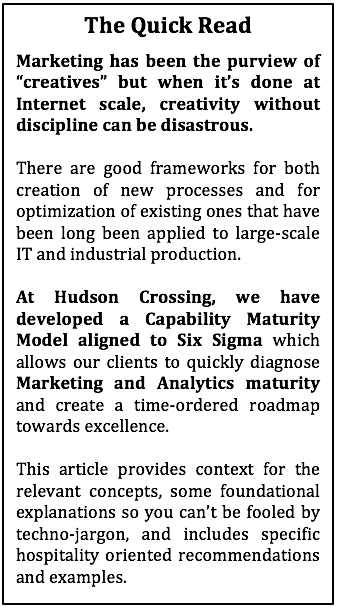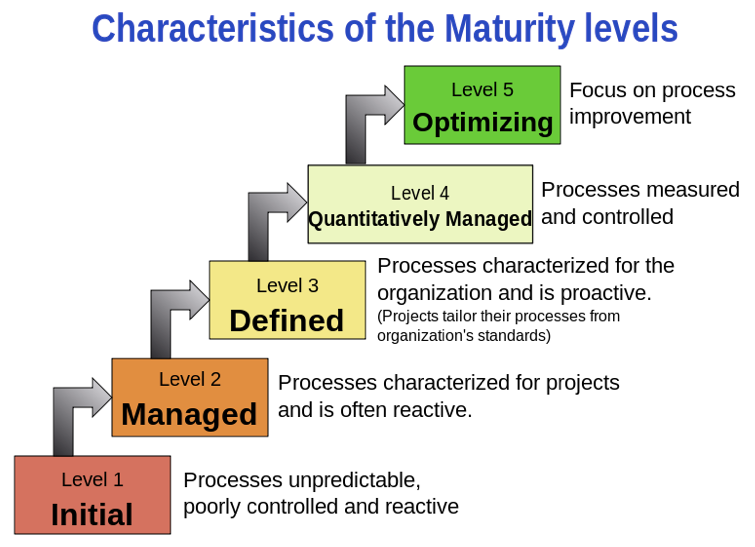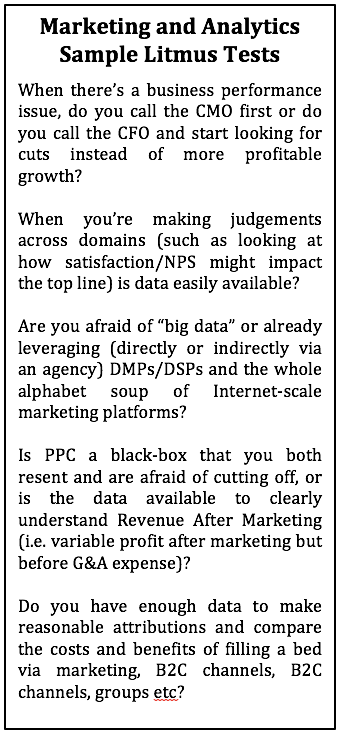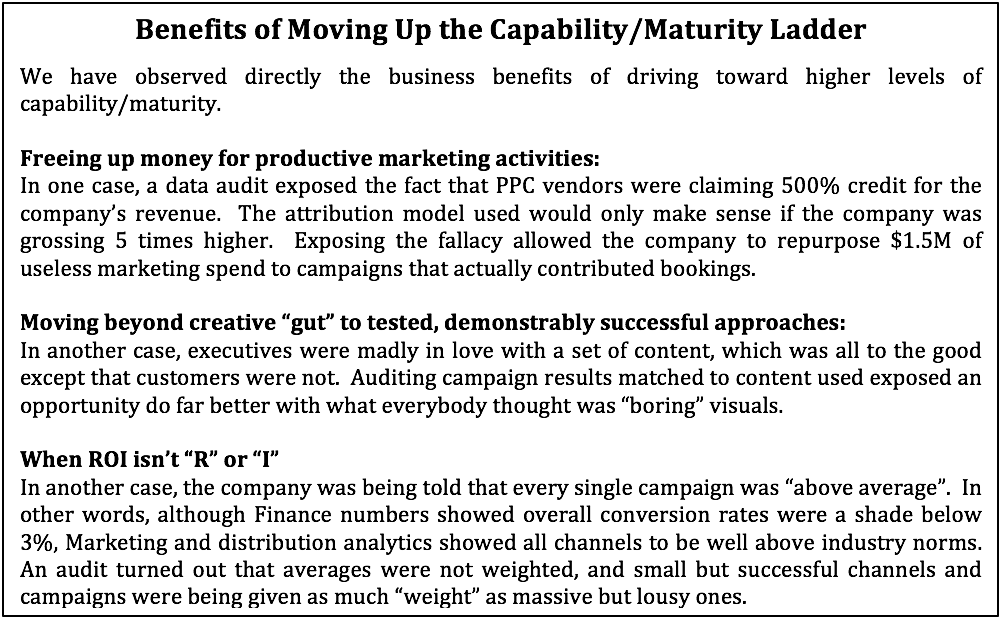 Back to Blogs
Back to Blogs
Toward a Marketing and Analytics Capability-Maturity Model
Marketing is undergoing a transition that bears some similarity to what happened to IT as software became more central to enterprise success
It’s probably high time to require Marketing to meet quality, reliability, and predictability “industrial strength” standards. Manufacturing and IT went through this transition first, but it’s Marketing’s turn: when you’re spending rivers of money at “Internet scale”, creativity alone is not just insufficient, it’s dangerous.
Just as IT’s early days were full of promise and led to sudden budget increases and ambitious transformational projects, the advent of digital marketing has led to vast increases in marketing & distribution budgets and matching ambitious projects.
What happened to IT, of course, was that in the 1980’s it became clear that while software was becoming central to enterprises of all types, it was quite often less than well managed. More and more complex projects either failed or were delivered late, over budget and under spec. Worse, the ability to evolve was often missing even if the initial delivery was successful.

In an effort to raise the level of IT management from an ad-hoc art to a repeatable high quality industrial process, the U.S. Department of Defense sponsored the development of a Capability Maturity Model (CMM) at Carnegie Mellon University. Meanwhile, at Motorola saw the introduction of Six Sigma (6s), to be followed by GE and many other industrials.
The CMM (originally focused on software engineering) has since been expanded to apply generally to various processes under the initials CMMI, Capability Maturity Model Integration, while 6s’s DMAIC process improvement (Define - Measure - Analyze - Improve – Control) and DMADV process design (Define – Measure – Analyze – Design – Verify) also got generalized to products, services, processes, etc.
In our consulting practice at Hudson Crossing we are observing a significant increase in travel, hospitality and e-commerce clients that are spending so much on marketing and distribution that, to paraphrase the saying, “a million here, a million there, and pretty soon you’re talking real money.”
In order to simplify diagnosing our clients’ situations we have adapted CMMI and 6s concepts to today’s digital marketing and big data analytics world. While the topic is complex and subject to the specific conditions of each company, this article provides a summary of executive level highlights.
For the purists, the logical relationship between CMMI and 6 Sigma may need some elaboration so let’s look at some foundational background first

At the highest conceptual level these can be elaborated as follows:
Immature/Level 0: Non-performing/Incomplete
Non-performing, or completely ad-hoc Marketing and Analytics practices.
Initial/Level 1: Performing Work
Performance may not be stable and may not meet specific objectives such as ROI, total cost-effectiveness, and schedule, but useful work is occurring.
Managed/Level 2: Managed Work
Marketing and Analytics tasks are planned, performed, monitored, and controlled for individual projects, groups, or stand-alone processes to achieve loyalty, distribution, revenue management and branding purposes. Both overall objectives and other KPIs, such as revenue after marketing spend, cost, schedule, and quality are managed.
Defined/Level 3: Managed with Defined Standards
Marketing and Analytics are not only managed but their goals are driven by fully documented standard processes. Goals, activities, campaigns and use of third parties are tailored to the enterprise’s priorities and outcomes are measured so that deviations in overall spending and revenue after marketing beyond those allowed by formal guidelines are documented, justified, reviewed, and approved.
Quantitatively Managed/Level 4: KPI-driven from High Integrity Data
Marketing and Analytics are quantitatively managed and driven by defined processes analyzed with statistical and other quantitative techniques. Data engineering produces reliable Analytics to evaluate overall and individual outcomes of Marketing activities across loyalty, distribution, revenue management and branding. Activities are understood in statistical terms, and are controlled throughout their entire life cycle.
Optimizing/Capability Level 5: Enhancing Enterprise Value
Marketing and Analytics processes are optimized on an ongoing basis to maximize enterprise value. Marketing and Analytics activities and initiatives are quantitatively managed processes that are improved based on root cause analysis and corrective action for any unexpected process variation. Marketing executives focus on continually improving enterprise outcomes through both incremental and innovative improvements. New creative efforts are subject to clear Define – Measure – Analyze – Design – Verify criteria and standard execution processes are ongoing targets of Define - Measure - Analyze - Improve – Control improvement activities.

These Concepts Have Direct Applications in Marketing and Analytics… Which Hoteliers Can Use to “Inspect What to Expect”
There are of course many shades of gray, and each case leads to different mapping between the answer to the questions below and a diagnoses of Capability/Maturity in Marketing and Analytics, but these are some of the key questions we often use to get discussions going:

Starting with “tone at the top”, how much do Marketing and Analytics contribute to key management decisions?
Do inputs from the CMO’s organization play a leading role in corporate planning and initiatives to enhance enterprise value?
Is Marketing and User Experience data broadly accessible without IT involvement being required to answer most business questions? Do the CMO and CFO “live in the same reality” and enjoy broad agreement of transactional and marketing analytics data?
Do you already enjoy enterprise integration of marketing insights? Is there clear data visibility and dimensional alignment across topics?
How easy is it for user experience detail such as Real User Measurement data to be joined to overall Web analytics, PPC and social engagement data? How well can these be broadly aligned with time-series of transactional and financial data?
Do you have near-real time autonomic data engineering processes that bring together creative initiatives, marketing campaigns, financial outcomes and channel transactional and CRM details?
Are the connections between guest satisfaction/NPS surveys, return rates, and ADRs and occupancies versus your competitive sets easy to analyze and leverage for improved results?
Are digital marketing platforms, Internet-scale signals and Big Data leveraged to plan, measure and optimize performance?
Beyond financial transactions, CRM and loyalty data, do you leverage both anonymous and identified data, micro-segments and real-time prospect/guest activity on social media?
Do you (or your external agencies) use Data Management Platforms (DMPs), Demand Side Platforms (DSPs), multi-variate ad generation and testing and programmatic creative platforms? Are you able to engage in mass customizations within micro-segments?
Does marketing lead the effort to managed data, apply consistent definitions and minimize disconnects?
Is there evidence of proactive management of an enterprise wide “data model” with repeatable, autonomic processes that expose issues and drive RCCA for any data disconnects between marketing and other enterprise functions?
Is the company collecting and organizing a permanent record of its Search Engine Result Page entries so it can relate content and other moves to ongoing improvements in desired primary search and long tail terms?
How well do Marketing and Analytics leverage operational details such as Folio data to analyze and proactively enhance guest lifetime value?
Small changes in median guest life time value can lead to huge changes in enterprise value.
This is true of both prospective value (guests who may be starting in life now but are likely to increase their spending over time) and current value (pre-arrival, current stay).
Are you able to personalize guest engagement and experiences beyond a single booking cycle by leveraging all available data to personalize the lifetime engagement of each prospect/guest?
Are you optimizing marketing outreach, distribution options and channel management?
Do Marketing and Analytics work hand in hand with revenue management and sales to leverage various options across seasons, channels and outbound campaigns?
Do you have an overall view of what demographics and which individuals are being targeted and specifically engaged? Are you able to leverage actual data to optimize engagement for life-time returns rather than disconnected individual campaigns?
Are you controlling and optimizing revenue after marketing expense and goaling marketing executives for measured, specific improvements in outcomes that include internal and external benchmarks?
Finally, how ad-hoc or data-driven is content generation?
Everybody knows that content needs to be optimized depending on the form factor that it’s going to be displayed on.
Less obvious is the need to let data drive content. Persuasive Marketing is not a dark art. Are you leveraging autonomic platforms that test and target content?

In summary, Marketing creativity, which we wholeheartedly endorse, should not became an excuse for lack of accountability
Just as IT had to grow up when it started really mattering (and costing accordingly), it’s time to insist on the maximum possible level of capability/maturity in Marketing.
Contrary to fears we occasionally hear expressed by Marketing execs and creatives this does not take the fun out of Marketing. To the contrary, the more convincingly that the benefits of a creative idea can be measured, the easier it is to get enterprise-wide support for it, and all the matching resources that come with that.
Wherever we’ve seen Marketing executives avoid the discipline of something akin to a capability/maturity model, we often see erratic and unpleasant outcomes.
Wherever we’ve seen CMOs embrace the path to full capability/maturity optimization, positive results have followed not just within Marketing as a function but with respect to improvements in overall enterprise value.
 Previous Post
Previous Post